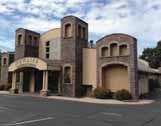







Cost of charity 19 Motivated to shape lives 26 Why to fail at parenting
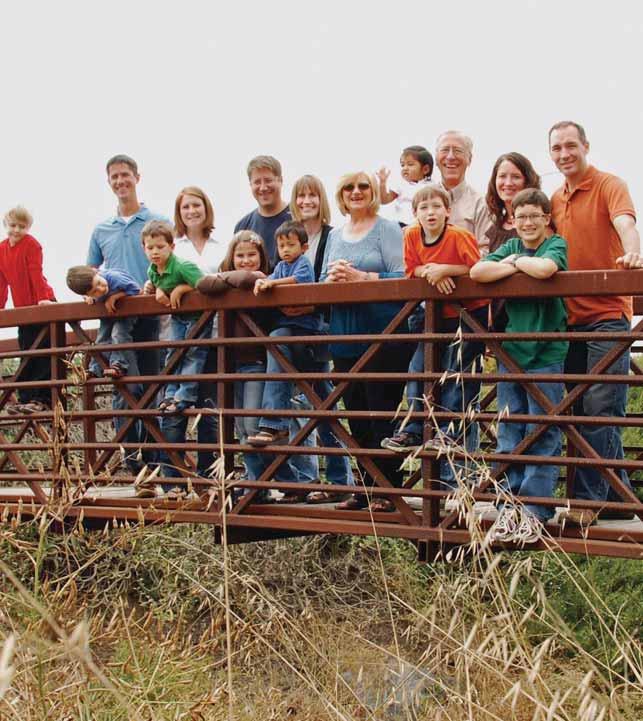






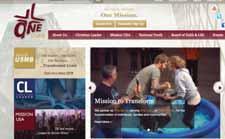
After years of driving the same cars, my family has recently enjoyed a burst of new car purchases. Riding in a new vehicle often brings with it the joy of that new car smell. It suggests a fresh start, new miles to be driven and adventures on the road ahead. Here at the Christian Leader, we are enjoying that new car smell twice over thanks to changes we are making.
New schedule: We made the decision in early 2014 to shift the Christian Leader production schedule so that our six annual issues match the calendar year. The easiest way to make this adjustment, we determined, was to publish a one-month issue in June, then resume our bimonthly schedule. So you are receiving this issue of the magazine and then we will resume our bimonthly schedule with a July/August issue. Our new publishing schedule will begin each calendar year with the January/February issue and will end with a November/December issue.
Here at the Christian Leader, we are enjoying that “new car smell” twice over thanks to changes we are making.

Connie Faber Editor
In a nod to the past, this single-month issue incorporates a theme for the feature section, a format that we followed for many years when the CL was a monthly publication. So in this issue you will read three essays that remind us to think carefully about how we care for the needy and how our charity and good intentions can sometimes do more harm than good.
New website: Guided by Lori Taylor, the USMB webmaster, USMB staff members have spent the last year working with a website design firm to improve the USMB website. The result is a new website that debuts this month. Visit www.usmb.org to see our updated look and to access resources that will keep you up to date with what’s happening in the USMB world.
• Read USMB Pulse, an online collection of ideas and stories that we hope will encourage us as we pursue our common mission to see individuals, families and communities transformed by God’s amazing grace.
• Visit the Mission USA department to read profiles of our current church plants.
• At CL Online you can read feature essays, columns and news articles from the current issue of the magazine. Additional resources not included in a feature article or news story in our print edition may be available at CL Online.
• Catch up on current news from the USMB world with stories from C-Link, our biweekly e-news digest, at CL Online.
• Join the discussion by commenting on any CL article, USMB Pulse story or Mission USA Snapshot story or Update article.
We hope you enjoy the “new car smell” of our enhanced website. So if something on the website doesn’t work quite right, please contact me at editor@usmb.org. Our aim is that this new website will be a helpful communication experience that serves you well.






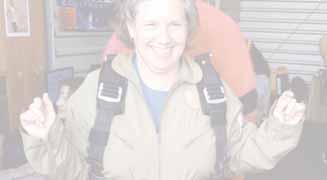









Paul Bartel

We recently bought a house that our church community plans to use for a new ministry venture. Currently it sits empty as we work on the interior. Tonight I found myself sitting on the back deck, leaning against the house, embracing the silence. It was a welcome far cry from the decibel-busting six hours spent earlier with four kids at my son’s birthday party.
The silence was lovely, at least for a moment. After a while, silence becomes disarming, particularly when there are no devices or dirty kitchens or DVRs to distract us. It was just the empty deck and me. All that was left was what was inside of me.
It is in the silence that I’m forced to reflect on those things that I otherwise manage so nicely: The darkness deep inside of me. The thoughts I’d rather no one know. The things I’m too ashamed to say. There’s no more hiding because it all seems to be laid bare in the silence.
I think David felt the same way when confronted by Nathan about the Bathsheba tragedy. Although he was not alone, everything was laid bare. There was no more hiding. In the midst of his pain and shame, I’m certain David felt some relief, like we all do once our secrets are exposed. That’s the only way the weight can begin to lift.
I believe God likes it this way. God wants us sitting on the back deck, no distractions, in the silence, exposed and broken. This is not because God is some kind of sadist; it is quite the opposite. God simply wants us. Stubborn as we are, it is usually only in brokenness that we turn to God. This is when we discover God’s love awaiting us, ready to forgive and embrace.
It once seemed strange to me that David could be such a scoundrel, yet considered the model of a man after God’s heart. Now it doesn’t surprise me a bit. In his darkest moments, when he was most aware of his frailty, David turned to God and found what he was searching for.
Just like David, we don’t want our secrets to be exposed. We don’t want to be found out. But it is only then that we will begin to discover the God who has already accepted us unconditionally. For that is the sacrifice acceptable to him— a broken spirit and a broken heart ready to finally be real with God. Are we scoundrels open to exposure? Are we ready to be broken so that we too may discover the heart of God?
Paul Bartel is part of Watershed, a Mennonite Brethren community in Kansas City.

“My sacrifice, God, is a broken spirit; a broken and contrite heart you, O God, will not despise.” Psalm 51:17
June 2014
Volume 77 • Number 3
Connie Faber EDITOR
Myra Holmes ASSISTANT EDITOR
Shelley Plett GRAPHIC DESIGNER
Harold Ens COVER PHOTO
See story on page 17
The Christian Leader (ISSN 0009-5149) is a gathering place for the people, passions and mission of U.S Mennonite Brethren. The Christian Leader is published bimonthly by the U.S. Conference of Mennonite Brethren Churches. However, the opinions expressed here are not necessarily those of the church as a whole.
COPYRIGHT The articles printed in the Christian Leader are owned by the CL or by the author and may not be reprinted without permission. Unless noted, Scripture quotations are from the New International Version.
READER PARTICIPATION Letters to the editor should be 300 words or less and on one subject. Letters must be signed and include the writer’s city and state. Letters will be edited for clarity, appropriateness and length. Letters will be published, as space allows, unless marked, “Not for publication.” Readers interested in contributing essays for In My Humble Opinion and First Person should contact the editor. Freelance article submissions are welcome; a SASE must accompany articles.
SUBSCRIPTIONS $10 for six issues and $20 for 12 issues ($15, $30 in Canada; all other countries $25 for six issues); $1.50 per copy
CORRESPONDENCE: All correspondence, including subscription questions and address updates, should be addressed to Christian Leader Box 155, 107 N. Main, Hillsboro, KS 67063-0155 Phone: 620.947.5543
E-mail: christianleader@usmb.org
MEMBERSHIP The Christian Leader is a member of the Evangelical Press Association and Meetinghouse, an association of Mennonite and Brethren in Christ editors.
POSTMASTER Send address changes to Christian Leader, Box 155, Hillsboro, KS 67063. Periodicals postage paid at Hillsboro, Kansas.
The Christian Leader is published by

U.S. Conference of MB Churches

Ed Boschman USMB executive director ebed@usmb.org
The notes are dated October 6, 1982. While I don’t remember the reason I wrote them, now is a good time to test their validity. The questions posed were: What concerns do you have for churches in our conference? What gives you reason for optimism for the future?
Five concerns were on my mind at the time: 1. A tendency away from healthy cross-denominational partnerships to Mennonite Brethren exclusivism. 2. The negative impact of multi-layered “norms” asked of the local church. 3. The emphasis on most anything except the salvation of pre-Christians we know. 4. The degree of emphasis on “foreign mission” at the expense of “home mission.” 5. Limited growth among USMB for decades.
Reasons for optimism were a longer list based on local churches that would: 1. Demonstrate visible unconditional love for one another. 2. Show willingness to trust and follow authentic, transparent Godanointed and appointed leadership. 3. Deemphasize ethnicity and tradition and affirm first generation Mennonite Brethren as first-class members. 4. Place denominationalism behind loyalty to Christ and his church. 5. Birth healthy churches and support them on their way. 6. Affirm budget lines for local evangelism that rival those of global mission. 7. Understand that peacemakers may have variations in how they practice following and obeying the Prince of Peace. 8. Resist the sometimes-evident spiritual pride about the conviction that we Mennonite Brethren are the faithful few who have theology right. 9. Commit to prayer as a primary agenda. 10. Accept the fact that it is OK not to know everyone at church. 11. Not be satisfied until there are new believers being added regularly to the church.
Because I do not pass muster as a prophet by biblical standards, these dated observations can and should be tested. After 40 years of serving in the USMB tribe, my inclination is to check for both validity and momentum. Some of them are “motherhood and apple pie.” Others are more incisive, or even confrontational.
What’s your take?
From a national perspective, we have much to be grateful for, and we have some momentum. In this last season we have rallied around our USMB goal to “Partner as one family, serving one Lord, on one mission, for the transformation of individuals, families and communities.” We haven’t always gotten it right, but sometimes we have.
In the last 18 years we have partnered with local churches and districts and across denominational lines to plant 27 new churches with a survival rate of 80 percent, well ahead of the national average. We have consistently invested in local church renewal and in leadership development. We have added brothers and sisters from multiple ethnicities to our family, and we are richer for it. We are learning to drop our regional and institutional boundaries and partner in effective ways for both leadership development and mission. We are grateful to have done so with MB Mission and are committed to expanding our collaboration. We have reviewed Jesus’ call to be peacemakers and are anticipating renewed commitment to pursue peace and reconciliation.
Thanks to our missional focus and local church serving emphasis—and in part to a change from the “norms” system of financial partnership to a percentage based model—we have in recent years added 22 local churches to the list of those which support the USMB National Ministries Fund. Additionally, we have developed a cadre of individual donors who are supportive of our ministries.
Ultimately, our mission is about transformed lives. The Spirit is at work convicting and convincing people of sin, righteousness and judgment, and many among us, corporately as church families and also as individuals, are partnering with him to invite and welcome people to a family of faith. May that tribe increase! Wouldn’t it be amazing to experience Acts 2 again: “praising God and enjoying the favor of all the people” while the Lord was adding to our number daily those who were being saved?
From a national perspective, we have much to be grateful for, and we have some momentum.
People don’t normally put the words “church” and “skydive” in the same sentence to describe a church-sponsored outing. But last Dec. 1 several of us from Madera Avenue Bible Church, Madera, Calif., left for Madera Parachute Center right after church to receive training and to sign our lives away. Others were invited to grab a bite to eat and then join us.
The four jumpers from our church were Sam Wall, Diane Kirk, Clay Garrison and myself. We were joined by friends Nicole Toews, Janice Lowder and Corrine Bartlett. Most of us went tandem, attached to an expert jumper who did most of the work and talked us through the jump. However, Clay, a colonel who heads the Fresno unit of the California Air National Guard, went through the training to jump accelerated free fall. The event took the entire afternoon, with the last jumpers landing just as the sun set. All jumps went without a problem.
What surprised me most was how many friends from church came to cheer us on. They watched the sky carefully to see us exit the plane from 10,500 feet. After about 30 seconds of free fall, the parachute opened up and then we sailed downward for a few minutes. The group welcomed each of us as we landed on the firm ground.
Maybe that support shouldn’t have surprised me. For my family that support and encouragement began seven years ago when God led us to Madera Avenue Bible Church. It humbles me each time—and it is often—that I hear someone in church pray for our family. We came to serve this church, but they have served and ministered to us even more.
You see, my husband, Pastor Tim Bergdahl, is currently fighting cancer and undergoing chemotherapy. Six months prior to his diagnosis, our young daughter was burned in a fire. Our church members have gathered around and supported us through thick and thin.
“Skydiving is a leap of faith,” says Janine Bergdahl.
The outpouring of their love has come through trickor-treat and Christmas bags for our children each year, delicious meals delivered to our home and anonymous cash gifts that always come at a needy time. People give us hugs and stop by to say hi. We’ve felt loved when someone picks up our daughter at school, drives Tim to and from chemotherapy and gives me clothes. The church has even kept us on full support as Tim has gone through over 50 rounds of chemotherapy. The list could go on an on. I couldn’t think of a better place for us to be during this difficult time in our lives.
Skydiving was a leap of faith. Letting go of a decently good airplane was pretty scary. Moving here to minister in Madera was not only a leap of faith for us but also the thrill of a lifetime. God is so very good! And so very often he shows his kindness and blessings through our church family. We love you, Madera Avenue Bible Church. Thank you for being our family!
Janine Bergdahl is a home economics teacher at Madera South High School. She and her husband, Tim,

When the USMB Leadership Board met March 14-15 in San Diego, Calif., board members spent most of Friday in executive session, focusing on the future of the conference as they discussed both long- and short-term issues that surround the retirement this summer of executive director Ed Boschman.
Addressing the immediate vacancy that will be created August 1 when Boschman retires, the Leadership Board appointed Don Morris as the interim USMB executive director. Morris has served as the director of Mission USA, the USMB church planting and renewal ministry, since 2004 and will add the executive director’s tasks to his current responsibilities.
The Leadership Board also discussed USMB’s long-term health and will be retaining a consultant that works with denominations to help the Leadership Board and other USMB leaders conduct a strategic review of the conference.
The Strategic Review Team, consisting of Steve Schroeder, Leadership Board chair; Marv Schellenberg, Leadership Board vice chair; Larry Nikkel, Board of Faith and Life chair; and Jon Wiebe, MB Foundation CEO, will vet possible consultants and make a recommendation to the board.
Schroeder says the board anticipates the review will take six months to a year and will involve district ministers and leaders of USMB partner ministries.—USMB
The USMB Board of Faith and Life has finalized the recommended changes for Article 13 of the Confession of Faith. The newly-titled article, “Love, Peacemaking and Reconciliation,” is the result of an extensive review process begun at a January 2013 study conference. The USMB Leadership Board will join the BFL in recommending this revision for delegate approval at Conection 2014 in July. The final recommendation has been forwarded to churches and is available online at http://www.usmb.org/. —USMB
Tabor College Wichita announces the launch of their new Master of Arts in Entrepreneurial Ministry Leadership (EML) degree, approved by the Higher Learning Commission in late February. The EML program is enrolling now and the first classes will be held in a onecourse-at-a-time cohort format beginning this fall. This program is intended to serve pastors, missionaries, church planters, visionaries, youth pastors, entrepreneurs and staff members who are preparing for new areas of service. For more information, visit www.tabor.edu or email Rick Bartlett at rickb@tabor.edu—TC
The National Youth Committee (NYC) has announced the speaker and musicians for Named 2015, the next National Youth Convention. John Richardson will be the speaker; For All Seasons will be the band.
Named 2015 will be April 9-12, 2015, in Denver, Colo. Richardson is the new campus pastor for Mountain View Community Church Sunnyside, Fresno, Calif., a campus of Mountain View Community Church and a church plant supported by USMB and the Pacific District Conference.
He holds a bachelor’s degree in contemporary Christian ministry from Fresno Pacific University, the Mennonite Brethren school headquartered in Fresno, Calif., and a master’s degree in Old Testament from Fresno Pacific Biblical Seminary, the denominational seminary, also in Fresno. He served as a youth pastor for 11 years in California’s Central Valley and has led over 100 teens on short-term mission trips to Africa. For All Seasons has experience leading music at camps and youth conferences with a style that has been compared to Jesus Culture. The five-member band’s newest album is “High Above It All,” available on iTunes. For more on For All Seasons, visit www.forallseasonsmusic.com. —NYC
Planning to attend Conection 2014 next month in Santa Clara, Calif.? Then it’s time to register now, says USMB event planner Donna Sullivan. Conection 2014 includes the National Pastors Conference July 24-25 and the National Convention July 25-26. All events will be held at the Santa Clara Marriott, Santa Clara, Calif. The deadline for hotel room reservations is July 7, but Sullivan notes that availability is limited and urges people to reserve rooms right away. To reserve a room, call 800-228-9290 and mention “USMB Conection 2014” or reserve online. Registration for the Pastors Conference and National Convention can also be completed online. Registration fees are $110 for the National Pastors Conference and $225 per person for the National Convention. Fees for children, which include both Conection 2014 events, are $100 for youth ages 12-18, $90 for children age 2-11 and no charge for children under two. Visit www.usmb.org/menus/conection2014.html to register.—USMB
There are more than 7 billion people in our world. What does that look like?
7 billion ants, at an average weight of 3 milligrams each, would weigh at least 23 tons or 46,297 pounds.
Take 7 billion steps along the earth’s equator, at 2 feet per step, and you could walk around the world at least 106 times.


7 billion seconds ago, the year was 1789, the year George Washington was inaugurated as the first U.S. president.
5 minutes with...
Back in 1994 Berniece Givan’s late husband, Glen, convinced her to cook a fellowship lunch for the senior members of their congregation. She never suspected that one-time event would turn into Neighborlinks, a twice-monthly meal that continues to minister to Garden Park Church’s members and neighbors. At age 83, Berniece has retired after 20 years giving leadership to this ministry in Denver, Colo.


What did you think about Glen’s idea for a seniors lunch?
I said, OK, but just this once. I had my own bookkeeping business and didn’t have me to do this regularly.
How did it become a regular event?
We had such a good me, and people kept asking us about it. We didn’t meet real regularly right at first, but a er a while I got into the rhythm of cooking and we se led into mee ng on the first and third Tuesdays of the month.
Where did the name Neighborlinks come from?
We never wrote out a mission statement like they always do now, but our mission was to give our neighbors a good meal once or twice a month and let them know that we are Biblebelieving and are interested in their welfare. Neighborlinks was a name that fit what we wanted to do.
Who comes to Neighborlinks?
It’s for people 55 years and older. About half the people are not from the church. One widow lady from the neighborhood had a heart for people and would invite other neighbors who didn’t have a church. Now we send out 60 to 70 flyers to people in the church and in the neighborhood.

Have there been discouraging times over these 20 years?
Everyone has mes when you’d like to quit, but you just get a good night’s sleep and start over. I had to keep remembering that this wasn’t my work. It was something given to us by God. He is faithful.
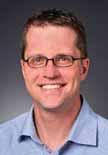
Jarrod Goentzel, a 1990 TC graduate with a bachelor of arts degree in mathematics, was the scheduled speaker for spring commencement May 17 at Tabor College, the USMB college headquartered in Hillsboro, Kan. Goentzel is the founder and director of Massachusetts Institute of Technology (MIT) Humanitarian Response Lab and is a research lead for the MIT Comprehensive Initiative on Technology Evaluation sponsored by United States Agency for International Development (USAID). An estimated 137 students from the Hillsboro campus and 42 from the Wichita campus participated in Tabor’s commencement exercises. —TC



Jon Pritchard, MB Mission’s regional mobilizer for the Midwest U.S. since January 2010, has resigned effective March 31. As regional mobilizer, Pritchard worked with Mennonite Brethren churches east of the Rocky Mountains to mobilize personnel for short and longterm mission, for prayer and for financial support. MB Mission is the global mission agency of North American Mennonite Brethren. —MB Mission



Kindred Productions (KP), the North American Mennonite Brethren publishing ministry, has updated its website to benefit both customers and the ministry. Elenore Doerksen, KP manager, says, “We redesigned the website to hopefully offer a better experience to users, to have a more modern look and to allow us more control over the content, functionality and layout of the site.” Visit www.kindredproductions.com. —KP

Fresno Pacific University’s spring commencement ceremony was held May 10 at Chukchansi Park (Grizzlies Stadium) in downtown Fresno, Calif., a new, larger venue mandated in part by the university’s increased enrollment over the past few years. The featured speaker was community activist and author Randy White, executive director of the FPU Center for Community Transformation. An estimated 188 students graduated from the traditional undergraduate program, 58 from the bachelor’s degree program and 93 from graduate programs, including 20 from the Fresno Pacific Biblical Seminary. FPU is the Mennonite Brethren school on the West Coast. —FPU

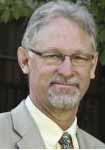
Richard Kyle, retired professor of history and religion at Tabor College, the Mennonite Brethren college in Hillsboro, Kan., has written God’s Watchman, a book that explores the faith, vocation and political ideas of John Knox. The book is published by Pickwick Publications and is available at www.wipfandstock.com.


MB Mission and other Mennonite Brethrenaffiliated ministries asked North Americans to pray for Ukraine and agency workers serving in the country during political unrest this spring. “Please pray with us for the country of Ukraine as they are entering a new chapter in their struggle for freedom,” wrote Randy Friesen, MB Mission general director, in an email to USMB churches in early March. The International Community of Mennonite Brethren and Family Life Network were also among those calling for prayer.


By Jamie Munday
Why helping someone in need can harm the giver and the receiver


Positioned carefully in the vacillating shadow of a large palm tree, the three of us exchanged stories as we sought relief from the oppressive afternoon sun. As we began to walk back into the classroom, the young Congolese student lowered his head slightly, cupped his hands together and submissively requested a few dollars to provide a meal for his children.
Murray Nickel, my associate, reacted with indignation: “Why would you do that?” he queried the student. “You and I are colleagues!”
At the time I felt Murray’s response was harsh, if not uncharitable. Over time I’ve come to realize that it was indeed uncharitable and therein lays its significance.
Murray, who is a medical doctor, and I had come to Kinshasa along with other Canadian doctors to host a training conference for Congolese medical students. Murray was well aware that a couple dollars would have no lasting impact on this young man’s family. Much worse, he knew it had the potential to transform the power dynamics of their relationship and slowly eat away at the dignity and self-respect of the young man. Taken in isolation, Murray’s response would be harsh, but given his experience serving and loving the Congolese people, his actions pointed to a more profound and effectual impact that lay beyond the “charitable impulse.”
“Charity,” in its modern definition, has come to mean “the voluntary giving of help, typically in the form of money, to those in need (Oxford.)” In recent years the word has taken on a markedly pejorative connotation. It is not uncommon to hear the refrain, “I don’t need your charity!” This is because people know innately that charity is not free, but it will cost them something.
According to theologian Jacques Ellul in the book Money and Power, “Almsgiving affirms the superiority of the giver, who thus gains a point on the recipient, binds him, demands gratitude, humiliates him and reduces him to a lower state than he had before. Almsgiving acts this way because it is a money relationship and not a love relationship.”
Charity may be harmful to the giver. As we offer our time, money and expertise we are filled with purpose and significance. This in itself is not a problem. However we are in grave danger when the nobility of our cause overshadows our compassion, for it spawns a mindset of superiority that is hostile to God’s kingdom. Our charity becomes self-serving and we are no different from the Pharisees who “give a tenth of their

spices…but have neglected the more important matters of the law—justice, mercy and faithfulness” (Matt 23:23.)
When we give in a manner that is self-serving, we isolate ourselves not only from God’s deeper purposes but also from the poor themselves, who, as Ellul points out, need our love much more than our money.
A second and more significant point is that our charity can be harmful to the poor. Regardless of intent, an act of charity can never be neutral. If it does not empower the poor to act with dignity and agency, the outcome will be negative over the long term.
In his book, Pedagogy of the Oppressed, Paulo Freire, the renowned Brazilian educator and advocate for the poor states, “False charity constrains the fearful and subdued, the ‘rejects of life,’ to extend their trembling hands.” This is not only a physical posture but also a psychological one that imprisons the poor behind the bars of shame, inferiority— and worthlessness.
that poverty is more than a lack of things—food, skills, knowledge—but a psychological and spiritual phenomenon that demands transformation at a deeper level.
In Walking with the Poor, his seminal work on transformational development, Bryant Myers suggests, “The greatest point of transformational leverage is transformed people.” In other words, the outcomes we desire to see in health, educa-
...We are in grave danger when the nobility of our cause overshadows our compassion.

The Bible not only urges us to reject false charity, but also instructs how to give in a way that is truly generous. It is illuminating to note that the familiar Greek word agape was translated into the Latin Vulgate as caritas. This is, of course, the root of the modern English word charity. When we maintain this intimate connection between love and charity, we get a fuller understanding of what Christian charity should entail.
For example, 1 Corinthians 13 would read: Charity is patient; charity is kind; charity is not envious or boastful or arrogant or rude. It does not insist on its own way; it is not irritable or resentful; it does not rejoice in wrongdoing, but rejoices in the truth. It bears all things, believes all things, hopes all things, endures all things.
More than just the voluntary giving of help, we see in the ancient understanding of charity a dimension of empathy and sacrifice that is demanded of the giver. Givers are in fact not asked to simply reduce the burden of the poor but in some way to bear that burden upon themselves.
A brief story from Acts 3 gives us a picture of what caritas might look like. We can easily relate to the apostle Peter who, walking through the temple courtyard, runs into a man clearly disabled from birth who asks him for money. After hearing the man’s request, Peter commands him, “Look at me!”
It is a shocking remark because for a first century Jew it flies in the face of social convention. With trembling hands extended and eyes cast downward, “Look at me” marks the beginning of this man’s transformation. You can almost see his posture begin to change, even before his physical disability is healed.
This is the place where true charity begins. To look into the eyes is to consider one’s being and to recognize one’s value. To see the poor eye-to-eye is to renounce any perceived hierarchy or condescension and to see individuals for who they are. It is to risk observing their sadness, loneliness or anger and in a small way to bear it upon oneself.
Ultimately Peter offers love instead of money: “Silver or gold I do not have, but what I have I give you. In the name of Jesus Christ of Nazareth, walk.” In order to move towards caritas we must first lay aside easy and reflexive solutions and look into the eyes of the poor. In doing so we come to realize
tion, peace or social justice will be unrealized no matter how carefully we evaluate the needs or how skillfully we engineer the solutions.
Myers continues, “The fulcrum for transformational change is no longer transferring resources or building capacity or increasing choices, as important as these things are. But these things count only if they take place in a way that allows the poor to recover their true identity and discover the vocation God intends for them.”
Is it possible to lay aside our penchant for problem solving? Can we turn our attention from the needs of the poor so that instead of having to “extend their trembling hands,” as Feire remarks, they might extend them “less and less in supplication, so that more and more they become human hands which work, and, working, transform the world.”
Instead of asking, “What do you need?” we must look into the eyes of the poor and ask, “What do you have?” Inherent to this question is the belief that God has uniquely created and qualified each person, and acting upon that recognition is the beginning of transformational development.
In 2 Kings 4, a woman laments to Elisha that her husband has died and she is about to lose her children as indentured slaves. Elisha responds to her need by asking, “What do you have in your house?” She replies, “Nothing,” overlooking for the moment a small jar of olive oil tucked away in her cupboard. When she recognizes this important asset and faithfully offers it to God, it becomes the source of transformation both in the life of her family and the wider community.
“What do you have?” represents a seismic shift in development thinking. In my experience it is so counterintuitive that the initial response of the poor is often bewildered silence, since they are accustomed to working with sympathetic benefactors and problem-solvers.
It is not, however, a quick-fix methodology but an attitude by which we must relate with the poor and evaluate the merit of our poverty interventions. It is a question that negates the self-importance of the giver, while affirming the significance of the poor as valued citizens and agents of change. Unlike charity as we know it, it is an attitude that is rooted in love, reflecting the true generosity of caritas
Jamie Munday is the community development coordinator at MB Mission whereby he trains, collaborates, learns, writes, listens and grows alongside a global team of holistic practitioners. He and his wife, Leah, have two young boys.
The goats were a nuisance, wandering
freely through the villages. It made sense to fence them in. Didn’t it?
The ink was barely dry on my Tabor College diploma when I first arrived in Southern Zaire (now Congo) to manage a feeding program for tuberculosis patients at a Mennonite Brethren mission hospital. With a grant from a European funding agency, I was also encouraged to help local villagers address the agricultural problems of the region.
One of the first things I noticed was the goats that roamed freely through the villages. Thin, smelly and covered with flies, they nonetheless wandered in and out of houses, defecated in the compounds, ate cassava (people’s staple food) from the drying racks, rummaged through the garbage and nibbled at the laundry drying in the sun. The goats destroyed gardens in the community protected by small, stick fences that were easily breached. I saw families become angry at each other when the animals of one ate the vegetables of the other. At best, these goats were a health hazard and a general nuisance.
Raised on a Minnesota farm, I had won awards for my pedigreed sheep. I understood the basic principles of animal husbandry. This experience combined with my anthropology courses at Tabor led me to conclude that there must be a better way to raise goats in Zaire.
After discussions with several local farmers, I ordered 50 rolls of wire from the United States that would be used to fence in farmers’ goats. By fencing in the goats, I reasoned, the people would be rid of several problems. They would also improve the nutrition of their animals that would graze on better grass in pastures outside the village. Farmers could monitor their animals inside the fence and augment their diets with millet, corn and grass. I saw a potential breakthrough in goat production in the community through the introduction of this new technology.
Meanwhile, political problems flared up in Zaire. Mail was lost and messages went undelivered. For reasons unknown, my order for 50 rolls of wire never arrived at its destination. The wire was never shipped and the goats continued to wreak havoc in the community.
I discovered, however, that most farmers could not have afforded to purchase rolls of wire from me.
Through observation and experience, I also learned more about goats.
1. God feeds the goats. Farmers may be responsible for feeding their families but God feeds the goats. A goat raised inside a fence, I learned, will surely go hungry. They are expected to scavenge. To help villagers achieve a better life, I had proposed a solution through which the goats would probably have starved to death.
2. Goats eat garbage. Though goats snatch cassava from the drying racks, they also eat garbage, drink rainwater from tin cans lying in the village and drain puddles that attract mosquitoes. I had said, in effect, “I have a great idea to help improve your lives—banish your garbage disposal systems from the village!”
3. Grass draws mosquitoes. The Anopheles mosquito that carries malaria is responsible for more deaths than any other living creature in the world. Goats destroy grass by tearing it off at the roots. Left to themselves, they will strip a village of grass thereby making it a less desirable habitat for mosquitoes. These indigenous lawn mowers that I tried to remove from the community help reduce malaria by controlling the grass.
4. Snakes dislike bare ground. A grassy compound is an invitation to snakes to join you at home. With a little help from their goats, villagers keep the ground bare around their houses, effectively discouraging these visits. If a snake slithers into the compound in spite of this precaution, you can usually find it by following its tracks in the dust. My proposal for improving goat production in the community implied removing its snake control system.
5. It’s cold at 3,000 feet. Grass walls are poor insulation against cold weather. However, goats inside your house will keep you warm. By trying to confine animals to fences outside the village, I was guaranteeing that people would be cold at night when dry season winds chilled the community.
6. Goats hear thieves. Some goats sleep inside the houses while other farmers build lean-to shelters under the eaves. People told of being awakened at night by the bleating of goats when thieves sneaked into their compounds. My suggestion for solving the community’s goat
problem was to keep nature’s burglar alarms outside the village. There they would be of no assistance and would probably even be stolen themselves.
7. Lions eat goats. One family tied its goat to a tree inside the compound and woke in the morning to find only the leash remaining. Tracks in the dust revealed that a lion had stopped by for a midnight snack. Goats that sleep in your house, how-
By D. Merrill Ewert
did not understand the physiological principles involved, I observed that health problems quickly spread throughout a herd when goats are raised in restricted quarters. However well-motivated, my proposal for improved animal husbandry practices had yet another fatal flaw.
The goats of Southern Zaire taught me some important lessons. First, farmers know more about their problems than we development workers usually realize. At the same time, we understand much less than we think we do. Generally, things are not what they seem to be. Urgent human needs often compel development workers to take immediate action. We draw on our training as we interpret the problems of development and reflect our own experience as we suggest possible solutions. Not surprisingly, this can lead to big mistakes.

ever, are reasonably safe. My plan for a goat pasture outside the village would have been tantamount to opening a cafeteria for the lions and leopards of Southern Zaire.
8. A sick goat is a dead goat. When you sleep with your goat, you usually notice when it’s ill. If animals sleep outside the village, they may become sick and die before you notice. An apparently sensible solution for raising goats had the potential for economic disaster should health problems enter a particular herd.
9. Every goat in Africa has worms. Goats raised in restricted areas have higher rates of infestation by internal parasites and are more susceptible to its consequences. Though I
Second, the process of development takes much longer than we imagine. Introducing new solutions before we understand the problems they are designed to solve is a serious but common mistake. It took me years to learn what Zairian farmers have always known. Short-term workers should be more modest in making development decisions.
Third, real understanding comes through relationships. I tested my goat fence proposal on various farmers who all agreed that it was a brilliant answer to a pressing local problem. Thus convinced of its viability, I moved ahead, believing “this is what the people want.” Much later, I learned that my friends had carefully told me exactly what they thought I wanted to hear. They did not want me to “lose face” or feel badly by disagreeing with my proposal. Some also felt that I might have some inside information that superseded what everyone had known for generations, that you couldn’t raise goats inside fences under those conditions. Only after I had established deeper, personal relationships with several individuals did I begin to understand some of the deeper problems of the community. Only then were people willing to point out the flaws and weaknesses in my suggestions.
Development is a process of growth through which people progressively become more aware of their own problems and committed to finding appropriate solutions. We can facilitate that process, provide technical information and encourage them in this quest for a better life. We must, however, be modest in proposing solutions to problems we may not understand. That understanding comes not as a result of our technical competence but through the personal relationships of trust with those whom we want to serve.
D. Merrill Ewert was president of Fresno Pacific University from 2002 to 2012 and now carries the designation President Emeritus. He earlier worked at Cornell University and Wheaton College and spent many years in development work, including stints with Mennonite Central Committee and Medical Assistance Programs. His article first appeared in this magazine in May/June 1987.


How we can serve without damaging the very people we are trying to help
What do the neighborhoods known as Blood Corner, MacArthur Park and The Devil’s Triangle have in common? The answer is found in their stories.
I visited Blood Corner a few years ago while in Los Angeles with a group of fellow students from Fresno Pacific Biblical Seminary. In 1989 there were more daytime murders on this corner then anywhere else in the United States, and that’s when it was nicknamed “Blood Corner.” That same year John Perkins moved his family into the neighborhood. Through the years more Christians bought homes in the neighborhood, joining together for neighborhood transformation. The neighborhood we saw did not look like the 1989 version and is no longer called “Blood Corner.”
A few days later our class visited another group of Christians who moved into the LA neighborhood near MacArthur Park, an area that in the early 1990s was literally deemed a war zone by the national government based on the number of murders the neighborhood was experiencing. Again, the neighborhood we were seeing was drastically different than how it was described from the early 1990’s.
“The Devil’s Triangle,” a neighborhood in Fresno, Calif., defined by the triangle created by three major freeways, is the community that my family moved into seven years ago. This neighborhood is home to Fresno’s highest crime rate and highest poverty. In 1996 there were more murders on a quarter-mile stretch of one of the neighborhood streets than anywhere else in the country. During this time the Lowell neighborhood was known as “The Devil’s Triangle.” But today, fewer and fewer people remember this title.
Each of these neighborhoods has one very important thing in common: Each has changed due to the transformative presence of Christians moving into the neighborhood. These communities may still be plagued by crime, drug sales, gang activity and poverty, but things change when Christians intentionally move into neighborhoods and engage appropriately.
These three stories have helped to anchor me in a philosophy of service. Whether leading groups into a short-term mission trip or being part of the ongoing community engagement in my own neighborhood, my philosophy is the same: “We strive to do service in such a way as to support long-term transformation. This happens when our group is prepared both in appropriate skills and anchored in a holistic theology, where we strive to truly learn from those we go to serve and the places we visit help us enter into long lasting meaningful relationships of mutual respect.”
By Matt Ford
Unfortunately as a youth pastor I have all too often seen, experienced and participated in community engagement that brings more harm than good. A few years ago I put together a summer program for our youth ministry which consisted of weekly pool parties, summer camps, Bible studies, Frisbee golf tournaments and much more. But I had not provided any service opportunities for our students.
So I called up my friend, Bob, who runs a local nonprofit organization to see if our students could participate in any projects he had going. He did have an amazing, ongoing house renovation project for which a lot of help was needed. As Bob talked, I realized that this project would not work. I was looking for a weekly service project that our students could engage in on a specific day of the week and during a specific time in the morning. Bob’s meaningful summer project did not fit with my specific logistics.
Since Bob is a friend, he found other projects for us. But these projects didn’t meet a real need, didn’t provide for real change and didn’t foster meaningful relationships. When I put my agenda before the real needs of the community, both my youth group and the neighborhood we served were robbed of any meaningful and lasting transformation.
Because of negative experiences like this, I have adopted some guiding principles that help me lead groups into service in a way that doesn’t damage the very people we are trying to help.
Guiding Principle 1: Never assume we are taking God into the place we are going to serve. We always start from the framework that God is already there, and we want to join him in what he is already doing in that place. This first principle has really helped our students and families see God, themselves and the places we go in a proper light. Our students understand that God cares deeply for all his creation and is currently at work making all things new. Every person and every place matters to God.
Guiding Principle 2: Desire to learn. Our primary motivation for going is anchored in our desire to be learners. We avoid going with an attitude that we have all the answers.
A little over a year ago our junior high ministry participated in World Vision’s 30-hour famine. While fasting for world hunger, we also wanted to serve our community. At the time my friend Bob was organizing volunteers for a total home renovation on a house just across the street from mine. As our group spent a Saturday afternoon painting the outside of this house, we intentionally took the time to hear the story of the man living in the house.
Each of these neighborhoods has one very important thing in common: Each has changed due to the transformative presence of Christians moving into the neighborhood.
This man had lived in this house most of his life. When crime was at a high, he built a 12-foot wall to surround his front yard. In fact, he built it twice and both times the police told him to tear the wall down. This man had lived in fear for decades and rarely spent any time outside of his house.
One day while Bob was working on the house, he introduced this man to one of the kids next door. The man learned through his interaction with his neighbors that the people in the neighborhood weren’t all that bad and that he didn’t need to live in fear. Now he spends his evenings sitting on his front porch. On a day where our junior high students served an urban poor neighborhood, they learned a lesson from Ephesians 2 on how the gospel of Jesus tears down the walls that divide us.
Guiding Principle 3: Anchor all we do in long-term, meaningful relationships. Aiming for long-term relationships helps us view those we serve as our friends instead of “those people.” A good friendship is centered on listening and knowing a person’s story. When we know someone’s story, the walls that divide us start to come down, making respect and dignity a splendid reality.
When I moved into the Lowell neighborhood, I became good friends with Nancy, who leads a youth ministry for teens in the neighborhood. I started volunteering with her ministry and over the years our two youth ministries have beautifully linked together. The partnership we have brings holistic, meaningful and lasting transformation to everyone from both youth groups as well as the neighborhood we live in.
Guiding Principle 4: Adopt a common story. While we specifically train for each ministry experience, it is more important that we tell a common story in all our gatherings.
The training we do for specific missions trips or service projects, whether going across the border or across the street, are essential to our desire to “help without hurting.” Our training specifically hits issues such as worldview, cultural awareness, poverty and specific logistics from the people we are going to serve or help.
More important than specific training is striving in our youth ministry to share a common story and to tell it all the time. This story centers on our understanding of God and our understanding of mission. Telling this story repeatedly has helped to anchor our students in a theology and practice that truly benefits others.
Guiding Principle 5: Finishing what we start. Sev-
eral years ago a service team from an affluent church outof-town came to our neighborhood to rebuild a broken fence that surrounded the backyard of a single lady. The group took three days to rip down the entire fence in her backyard and then two days to build about half of the new fence. Despite the unfinished work that left her backyard completely open, the church group went home feeling really good about their ministry. But this woman had a less than positive experience. When we serve, we commit to finishing what we start.
The Apostle John opens his gospel story by saying, “In the beginning was the Word, and the Word was with God, and the Word was God. He was with God in the beginning. Through him all things were made; without him nothing was made that has been made. In him was life, and that life was the light of men. The light shines in the darkness, but the darkness has not understood it…. The Word became flesh and made his dwelling among us.”
Two things strike me. First is the reference to the creation story. John seems intent on making it clear that God is doing something new—that a new creation is at hand. Just as God brought forth life out of chaos and nothingness in Genesis, God is birthing a new creation through Jesus where all that is dead will be made alive and all that is broken will be fixed.
John also wants his readers to know that God chooses to roll up his sleeves and get dirty. God doesn’t do his work from a distance but from the trenches and chaos of our current situation. God became flesh and moved into the neighborhood. Too many churches engage mission or service from a distance. We go into a certain setting for a short period of time with all of our answers, but rarely does this kind of service produce any longlasting transformation.
May our service be anchored in a holistic theology as we strive to truly learn from those we go to serve, entering into meaningful and lasting relationships of mutual respect. And may we understand that when Christians who are transformed by the gospel of Jesus thoughtfully enter and intentionally engage in a broken community, they will be a transformative presence.
Matt Ford is pastor of student and family ministries at North Fresno MB Church in Fresno, Calif. He has served in full-time vocational youth ministry for 15 years and is a 2000 graduate of Fresno Pacific University and a 2012 graduate of Fresno Pacific Biblical Seminary. He and his
It was a simple choice that set a trajectory that now guides a family on mission into the third generation: In the 1960s, a newly-minted teacher chose voluntary service with the Mennonite Brethren—teaching high school in Colombia— as conscientious objection to the U.S. army.
Some four decades later, Harold Ens is retired from a missionary career that included service in DR Congo and Panama and mission administrator, first of Latin America, then as general director of the international MB mission agency. Now he and his wife, Helen, watch their three children and families serve God: Carmen and her husband, Andy Owen, in Thailand long-term; Lowell and his wife, Melissa, completing a three-year term in Peru; and Matt and his wife, Anne, nurturing a church plant in California. So what turns one man’s choice into a generational family business?
Though Harold and Helen are the first to carry the title “missionary,” the family legacy of mission-heartedness doesn’t start with them.
Growing up on a farm in Reedley, Calif., Harold watched his father develop chapels for farm workers and spend many Sundays preaching to Dustbowl families. In rural Kansas, Helen’s parents opened a door to the world by hosting traveling missionaries and by encouraging her to serve an eye-opening summer term with Mennonite Central Committee.
From their respective locations, Harold and Helen chose to join the Christian service team in Cali, Colombia, and the rest is history. Married upon their return to the U.S., they soon followed their sense of God’s leading abroad again, serving four years in an international school in DR Congo, then taking a supporting role to the indigenous Mennonite Brethren churches in
Panama, where their own children learned by watching and doing.
“Growing up in Panama really gave (the children) a picture of mission,” says Harold. At the Indian center in Panama City where Harold and Helen ministered to youth from Emberra and Wounaan tribes, preteen Carmen’s tasks involved making popsicles or preparing crafts. She recalls “feeling it was a privilege to be there with my folks, being involved in what they were doing.”
Lowell, who remembers accompanying his father on trips to the jungle, now takes one of his own children with him when his work in Peru involves visiting churches. “These trips are a highlight,” he says.
When the Ens family returned to the U.S. for Harold to take up the mantle of administrator for the Latin American field, they tried to be sensitive to the needs of their children. In Hillsboro, Kan., where they settled, there were three Mennonite Brethren churches. Carmen and Lowell were drawn in by the youth group at one, so that was where the family went together.
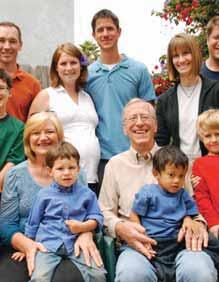
Similarly, the Owens make decisions as a family. Even with big decisions like moving, “we ask (the children) to pray and hear from the Lord,” says Carmen.
“Our home was always open to people,” says Helen. While in Panama, several indigenous Panamanian students lived with the family for periods of several weeks to two years. Other times, a couple would stay over for marriage counseling. Back on U.S. soil, “we would invite anyone we found,” says Helen.
Matt says, “I experienced the heart of discipleship firsthand.”
He watched his parents adopt spiritual children as they trained, empowered and promoted the next generation of local leaders in Panama. “The
platform was anywhere the people were: the indigenous church, our Mitsubishi minivan, our kitchen table.”
In every sphere of life, prayer is central for the Ens family. In his years in mission administration, Harold crisscrossed the globe and visited hundreds of North American MB churches. He’s taken planes, trains and automobiles aplenty, and faced the danger that comes with travel both international and domestic. “It’s only by God’s grace I’m here for retirement,” he says.
“Many times in churches where I’d go for mission conferences, people would stop me and say, ‘Just want to let you know we pray for you every day,’” he says.
Likewise, Carmen has received “countless” emails assuring her family of prayer support. “So often it coincides with a very specific need or impact season,” she says. “We see how clearly the Lord is speaking to his faithful prayer warriors.”
Lowell values prayer support above all. “When we were fundraising, I told people, ‘It’s great if you help our financial needs, but I’d rather you just pray for us. God’s got the money,…If you will commit to pray for us, I know that God will take care of the rest.’”
Overseas work is full of variety and adventure—and risk and sacrifice. Sometimes the tough things are unexpected. Returning to the U.S. when Harold took a job in administration was actually “the most difficult cross-cultural experience.”
Relocating from cosmopolitan Panama City to Hillsboro, a town of 3,000, “the children said, ‘Where are the stoplights?’” says Harold.
As his adjustment to U.S. life was rough, Lowell has watched his children struggle in Peru. Despite Lowell and Melissa’s best intentions to immerse their children in the culture, the school system of rote learning was so ill-suited for the children
that Melissa ended up home schooling. Lacking opportunities to know either local or expatriate peers, Mikaela, Toby and Timothy especially miss deep friendships with children they can understand at a profound level.
When Carmen’s young son came home from Thai nursery school saying Buddhist prayers, she learned to trust that “God’s promises for my children are the same: He will never leave or forsake us; he’s called us and will finish the work he began.”
God’s faithfulness is where the story starts and ends. “It’s been the best of all worlds if I look back now over 13 years raising my children overseas,” says Carmen. “The Lord has blessed us.”
Lowell says, “Mission has been such a part of us. I have no regrets for having followed God’s call to Peru.” Even as he brings his family home to the U.S., he trusts his children will have an inheritance of mission as he did.
Anyone can raise missional-minded children by “grabbing the opportunities you’ve got,” says Helen.
“Encourage multicultural exposure,” says Harold. “Learn another language. Have people in your home who are not like you. If you can travel, go into other cultures.”
Even in North America, parents can stretch their children’s understanding of the world. “If there’s a missionary coming to your area, bring them home, let them get to know your kids,” says Helen. “(In your own city,) get outside your comfort zone so your kids can know there are other precious people besides your own kind.”
Karla Braun
This article was first published in the MB Herald, the English-language magazine of the Canadian Conference of MB Churches, and is reprinted with permission. The full article is posted online at www.usmb.org/departments/christian-leader.html

Editor’s Note: Last month more than 500 men and women graduated from our U.S. Mennonite Brethren schools— Fresno Pacific University in California and Tabor College in Kansas. TC graduate Zachary Trostel-Lopes is an example of the kinds of students who attend our USMB schools, preparing for a life of work and service.
Whether teaching in an elementary school classroom or leading a junior high youth group, Zachary Trostel-Lopes has a heart for shaping lives.
A senior at Tabor College in Hillsboro, Kan., TrostelLopes’ life course began to take shape upon coming to faith in Jesus as an eighth grader.
“It just kind of clicked one day,” he says. “I was a good person, but just because you’re a good person, doesn’t mean you’re a Christian. You have to humble yourself and ask for forgiveness and receive salvation and acknowledge that Jesus is the only answer.”
That experience now fuels his passion to work with youth and help them find faith in Jesus.
“Some kid may never see Jesus except through me, or someone else,” he says. “I really like living out my relationship with Christ by how I love those around me.
“You can say a lot of words, but you’re not going to affect someone’s heart unless you’re showing them how much you love them.”
A native of Reedley, Calif., Trostel-Lopes calls the Reedley MB Church home.
During his junior year at Immanuel High School, TrostelLopes started helping with the junior high youth at church under the direction of Lee Waldron, the junior high pastor at the time.
Waldron, who currently serves as director of admissions at Tabor, says Trostel-Lopes had a gift for working with kids.
“Just by watching (Zack) and the way he handled students and the patience he had for them, I just knew that he was going to either be a teacher or a youth pastor someday,” Waldron says. “He had the patience, love and compassion to really make a difference and make kids feel special.”
Trostel-Lopes, too, began to realize his passion.
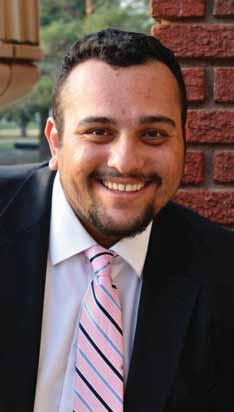
Three Tabor College graduates influenced Zachary Trostel-Lopes' decision to attend Tabor College, and Trostel-Lopes chose to be a teacher so that he can influence others.
“That’s where my heart for junior high students started to develop,” he says.
As he finished high school, Trostel-Lopes’ college decision was influenced by Waldron; his high school youth pastor, Jason Hofer; and his high school math teacher and golf coach, Phil Goertzen. All three had attended Tabor.
“All three of those guys helped me out a lot with figuring out, more than what did I want to do, but who was I and where did I want to go,” Trostel-Lopes says. “I’d say they were my big three for how I came to Tabor.”
Upon graduating from Immanuel in 2010, Trostel-Lopes chose to pursue an elementary education degree at Tabor.
“I want to be a teacher for the amount of influence I have,” he says. “I look back and think about all the teachers that I had and how some of them were great and then later on I found out they were believers in Christ. I want to teach with a Christian approach and Christian mindset.”
Trostel-Lopes’ elementary education advisor, Joanne Loewen, describes him as a good role model, team player and leader.
“He loves the kids, and he wants to make a difference in their lives,” she says. “He wants to do more than just teach them how to add or subtract or write; he wants to use that as a tool to reach them.
“He cares about the whole child beyond their education in the classroom.”
As a freshman, Trostel-Lopes began attending Ebenfeld MB Church of rural Hillsboro, where he got involved as an assistant with the junior high youth group and became the leader his junior year.
“I just have a huge desire for kids to, first and foremost, see Jesus,” Trostel-Lopes says. “Then when the kids do know Jesus, when they come to church that it’s not just something they do because, ‘Well, my mom had me come; my dad had me come,’ but it’s something that they’re like, ‘I want to come to church because I want to develop my love relationship with my heavenly Father.’”
Associate Pastor Brandon Voth, who oversees the high school and junior high ministries, says he’s seen Trostel-Lopes grow in confidence and leadership.
“Zack’s very responsible,” Voth says. “He’s not afraid to take on leadership roles, and he does very well at them. He also knows how to have fun. He works hard and he plays hard. He has a real compassionate heart for others.
“(Zack) also has a really good mind for making things easy to relate to for the junior high kids.”
Trostel-Lopes has also been an active part of the Tabor campus.
“Zack is pretty special,” Waldron says. “He’s involved in so much. Everybody loves a personality like Zack’s. You look around and he’s making people laugh. He gets along with everybody.”
Trostel-Lopes is the senior class president, having served as class vice president the previous two years. He is a member of Student Senate and vice president of the Student Activities Board.
He has been a resident assistant three years and was a peer mentor for a group of freshmen this year. He also helped facilitate a student-led men’s Bible study two years.
He has been part of the CHUMS after-school program all four years, including leader of the middle school program for two years, and has served as a student representative on the Teacher Education Committee Board for three years.
“I know I’m not the best leader in the world, but I’ve been able to develop skills by working with other leaders that are amazing,” Trostel-Lopes says. “I’ve been able to grow because of people around me.”
Waldron has enjoyed watching the transformation.
“What’s been neat now is I’ve gotten to see a little more of the process with the way God’s been working in his life,” he says. “I’ve seen him really flourish here.”
Trostel-Lopes intends to settle in California after graduating and is already planning to help with his former high school youth group at Reedley MB.
One day, he aspires to become a principal, he says, in order to have an even larger sphere of influence.
“Some people feel called to go to Africa; some people feel called to go to Detroit, but I feel called to serve those around me,” he says. “Serving other places is very important, but I think people often forget to serve and love those around them, so I try to do that.”
Waldron looks forward to seeing God’s continued work.
“I’m curious and excited to see what God has in store for Zack, but I know that he’s going to impact lives,” he says. “He’s made an impact at Tabor.
“I’ve gotten a chance to be a cheerleader on the side and watch him take God’s calling, accept it and run with it to where now he’s prepared to go on and do great things,” says Waldron. “Zack’s touched many lives here and we’ll miss him, but his story is just getting started.”— Janae Rempel












It was already Thursday of the week before Easter. Southern District Minister Tim Sullivan hadn’t started on the week’s classwork for the Evangelical Anabaptist Confessions of Faith class he was enrolled in. But he wasn’t worried about how he would fit the required class discussion into his busy Easter schedule.
Even if he couldn’t get to it until late Saturday evening, he could just plop down in his overstuffed recliner with his laptop computer and open up the website to catch up on the online conversation with classmates.
The online class Sullivan is enrolled in is part of an effort to make theological education more accessible to Mennonite Brethren leaders. Board of Faith and Life Chair Larry Nikkel calls it “a new day for our denomination.”
Evangelical Anabaptist Confessions of Faith is one of eight online classes that cover the essentials of Mennonite Brethren theology and practice (see page 22). Both Tabor College and Fresno Pacific Biblical Seminary (FPBS) are offering these courses, accessible from an Internet-connected computer anywhere in the world.
Offered since fall semester 2012, the courses have been attracting Mennonite Brethren pastors and those training for ministry, especially people whose locations or schedules don’t allow them to be physically present for a class.
Jordan Ringhofer, associate pastor of youth and worship at Kingsburg (Calif.) MB Church, is working toward a master of divinity degree, but between his church responsibilities and various conference involvements his schedule is
packed. Taking FPBS’s Evangelical Anabaptist Confessions of Faith last fall, the online format allowed him to fit the class in, working on it late at night or making use of a few moments waiting for an appointment.
“It was incredibly flexible. I did posts from home, from Starbucks and even during the Pacific District Conference convention,” he says. “The weekly deadlines helped me not to procrastinate, but (working online) allowed me to do the posts on my own schedule.”
Another attractive feature of the online MB courses is that they are being offered free of charge. Through a tuition subsidy, any pastor or member of a Mennonite Brethren church can earn the credits tuition-free.
A discount of 75 percent of tuition costs is funded by monies set aside at the divestiture of MB Biblical Seminary. Fresno Pacific Biblical Seminary and Tabor College each provide their MB students with a 25 percent scholarship so that the tuition cost is fully covered for those who complete the course for credit.
But don’t let free tuition or the mental pictures of Ringhofer at Starbucks and Sullivan in his recliner fool you. These are rigorous, graduate-level courses that require students to do extensive reading, research and analysis.
Professor Valerie Rempel of FPBS, who taught Evangelical Anabaptist Confessions of Faith, was concerned that it might be too rigorous. “I thought it was a ton of reading,” she says, “but students engaged and I was amazed at how much they liked the course.”

Fresno Pacific Biblical Seminary offers a nine-unit certificate in Mennonite Brethren Studies made up of two required courses—The Evangelical Anabaptist Story and Evangelical Anabaptist Confessions—plus one elective selected from the following six offerings:
- The Church and God’s Mission- Discipleship and Ethics
- Biblical Theology 1 and 2- Evangelical Anabaptist
Mission and Evangelism- Cultural Hermeneutics and Contextualization.
Tabor College offers the same set of courses as a credentialing requirement for pastors in the Southern District.
Rick Bartlett, Tabor College’s director of theological education, expects to draw students from across the U.S. and beyond to Tabor College’s new master’s-level Entrepreneurial Ministry Leadership (EML) degree because all coursework will be online except for a one-week class in Wichita and 10 days of international study in Thailand. This degree is the first online graduate degree offered by a U.S. Mennonite Brethren institution.
Tabor will enroll its first class of students for the EML program this fall. The program is targeted to people in ministry roles who want to explore creative ways to serve their communities—to “see a need and fill a need,” Bartlett says. The course includes a customized study focus for each student and is suitable for people involved in church ministry as well as community-based and nonprofit work. He is looking forward to implementing many of the unique possibilities that webbased study allows, from the creation of online learning communities he calls “guilds” to accessing live interaction with experienced leaders such as MB Mission Executive Director Randy Friesen in Canada and Mennonite World Conference General Secretary Cesar Garcia in Colombia.
At FPBS students earn three units of graduate credit in the semesterlong courses. Tabor’s program packs the same course material into a 10week intensive schedule.
How does all this happen online? Under the attentive view and constant evaluation of the two institutions’ graduate-level faculty. Some have taught these same courses in a live classroom setting. Others teach only online.
Faculty-student interaction all takes place on the Internet. Students can contact faculty via email with direct questions, but most of the dialog happens in online discussion forums where interactions between students take place over a period of hours or days. Students’ posts in the forums demonstrate their familiarity with the assigned reading or activity.
As students read each other’s posts and write responses, the result is a long string of dialog—a written version of the kind of oral discussion students typically have in the classroom. As in a classroom, the professor moderates and stimulates the discussion with additional questions or comments.
“It’s interesting to watch people who are in church ministry in various contexts have conversation around these topics,” Rempel says. “People can process their experiences in ministry in an online forum with a certain degree of freedom because the other person isn’t your fellow church member or sitting next to you in a classroom.”
Students’ experience of the material is enriched by interaction with people living and ministering in diverse settings. The online format has brought together students from different states and even different countries. “The cross-fertilization between locations and cultures adds a richness you can’t duplicate in a classroom setting,” Rempel says.
So while Sullivan may be sitting in his recliner finishing up this week’s assignments, he is not coasting through an easy course of study. A graduate of Tabor College and MB Biblical Seminary with 35 years as part of the MB church, Sullivan says he has never dealt with MB history and theology in such a focused way as in the two core courses he has taken.
“I can’t say enough about how I’ve benefitted and learned. I’m really glad I took them,” he says. —Kathy Heinrichs Wiest












Don Morris Mission USA director
The emotional health and well-being of our USMB pastors and their families is an important issue to address. I am convinced this is a problem about which few people in our churches are fully aware.
Simply put, we have several pastors, associate pastors and church planters experiencing mounting emotional pressure and feelings of discouragement. This is not a concern just in our churches but in churches all across America. According to statistics provided from studies of American pastors by Barna Research and The Fuller Institute:
• 80 percent of pastors surveyed believe pastoral ministry has negatively affected their families.
• 80 percent of pastors and 84 percent of their spouses feel unqualified and discouraged in their role as pastors.
• 90 percent of pastors said the ministry was completely different than what they thought it would be like before they entered the ministry.
• 70 percent do not have someone they consider a close friend.
• 50 percent feel so discouraged that they would leave the ministry if they could, but have no other way of making a living.
• Over 1,700 pastors left the ministry every month last year.
These are staggering statistics. And while there are certainly many, many pastors who are fulfilled in ministry and thoroughly enjoy what they are doing, sadly there are many who are simply


struggling, often with no one knowing. What can we do about this?
I can tell you that on the national and district level we often pointedly ask our church planters questions such as: How are you doing—really? Are you and your wife doing well in your marriage, spending quality time as a family? Are you taking a day off, getting adequate rest?
If you are a leader in your church, ask your pastors the same questions. We’re also attempting to provide more tangible ministries for USMB pastors such as life-on-life coaching and connecting points with other pastors.
One of the reasons for pastoral burnout or emotional fatigue is that pastors are constantly giving of themselves. This can be extremely draining emotionally and physically over time. Pastors often do not have adequate means to refuel. So I encourage you to also make sure your pastor gets adequate time away—that your pastor is given some Sundays out of the pulpit to get extra mental and emotional rest.
And for sure, every seven years provide your pastor with an extended opportunity for a “sabbatical rest” of three months or more. Saying “Well, I don’t get a sabbatical!” is not understanding the constant emotional and spiritual effort your pastor is providing for you and your church. Being a pastor, whether it’s as a lead or associate pastor or a church planter, is hard work. Let’s do all we can to take care of our spiritual shepherds. I firmly believe God will honor that!



The church plant core team for The GreenHouse, a USMB church plant in Saratoga Springs, Utah, led by Jason and Nicole Quiring, is making connections with their community.
Easter Sunday, 28 people went up the hill close to the Quiring’s home for a time of worship and sharing. Quiring spoke about beauty coming from failure and life coming from death using John 12:23-28 and other New Testament passages that “all point clearly to the person, work and sacrifice of Jesus being complete.”
Nicole used colored plastic eggs filled with symbols of the story of Christ’s death and resurrection to share the Easter story with children who were present. “This story is taken for granted in many of our churches but takes on a whole deeper meaning here in Utah,” says Quiring, referring to this predominantly Mormon state.
When the group returned to the Quiring’s house another dozen people joined them for a brunch. “It was so fun to sense and hear people’s surprise at how welcoming our core team was. I was so proud of how the gospel is taking root in our core people,” says Quiring.
“Please pray that these connections continue to deepen and expand. There were several families that we
invited but didn’t respond,” he says. “Pray that we can continue to reach out to them and meet them where they’re at in life.”
The GreenHouse is a partnership plant of Henderson (Neb.) MB Church, Fairview (Okla.) MB Church, New Hopedale (Okla.) MB Church, the Pacific District Conference and Mission USA.—Mission USA

Grace Point@McAllen, a USMB church plant in McAllen, Texas, recently shifted its gatherings from a hotel on the south side of the city to a newly remodeled facility on the north side. The new location gives the congregation room to grow and a new neighborhood to serve.
In preparation for its grand opening celebration Easter Sunday at the new location, Grace Point@McAllen invited households in the community to enjoy a free barbeque

chicken meal served at their new site. During the meal, Grace Point members visited with their 200-some guests, getting to know them and inviting them to the Easter service.
Thanks to the meal and other efforts to connect with the community, attendance Easter Sunday at Grace Point@McAllen was 25 percent higher than usual. More importantly, God was at work. “We were excited to see two people confess Jesus as Lord and Savior,” says Aaron Hernandez, Grace Point pastor. The following Sunday six individuals were baptized in a joint service with Grace Point @ Grulla, Grace Point@McAllen’s mother congregation.
In early May the two Grace Point congregations worked together to give away 1,000 plates of food to teachers and staff at 12 schools in La Grulla, Rio Grande City, Hidalgo and McAllen. The plates were packed with chicken, rice, beans and potato salad.
“We wanted to thank them for their work,” says Hernandez, “and remind them that God loves them and that we as a church are praying for them.”


Saturday was a bad day. Well, actually about 30 minutes was bad. The brief spurt between the end of my son’s basketball game and our departure for family pictures was unadulterated chaos.
The majority of the disaster revolved around two things: my son’s meltdown and my reaction. In the course of half an hour I acted in ways I never want to behave as a father—being impatient, threatening punishment and yelling. While I hate that I reacted in those ways, I do think there are some redemptive things that can come out of such parenting failures.
1. The opportunity to model responsibility. When I fail as a dad in one respect or another, I have the opportunity to take responsibility for my actions. I could have given my son all the “reasons” I didn’t react the way I should have. I could have pushed the blame onto him for melting down—because an eight-year-old should be more mature than a 35-year-old, right?
We live in a society that often seeks every course of action other than taking responsibility for one’s own actions. I don’t want my son to grow up to be one of those people. Times like Saturday allow me to go to him and clearly take responsibility for my actions.
2. The opportunity to engage conflict in healthy ways.
I have avoided conflict for as long as I can remember. That’s not a good thing. When conflict is avoided or mishandled it leads to a negative impact on relationships. When it is engaged and worked through, conflict actually adds depth and character to relationships. It makes our relationships stronger. I’ve been
learning that, especially these past five years, and this was another opportunity to grow as a person and model positive conflict resolution for my son.
3. The opportunity for my son to extend forgiveness.
I won’t be the only one who does something wrong to my son in his life. I also won’t be the only one who wants to be forgiven. I want to be a person who can forgive others, and I want that for my kids too. My failure gave my son the opportunity to practice forgiving. I hope this leads to an ability to forgive others as well—even those who don’t particularly care to be forgiven.
4. The opportunity to be forgiven. I would rather extend forgiveness to someone than receive it myself. I have an especially hard time forgiving myself when I mess up with my kids, my wife or others I love. But I need to be able to receive forgiveness from others. It is an important part of deep relationships and is a core component of my faith.
5. The opportunity to see the strength of our relationship.
Later that Saturday we had some good times together. As our family was riding in the car, I was struck by the beauty of relationships that can withstand meltdowns and failures. Our relationship is no worse off because of his meltdown or my failure in response. If anything, it’s probably better. I was overwhelmed by the beauty of this, and it made me long to continue becoming the kind of parent, husband and friend who can fail and be failed by others.
Trevor Lee is the lead pastor at Trailhead Church, Centennial, Colo.

Carmen Andres
It’s not hard to see why headlines proclaim this as Hollywood’s “Year of the Bible.” Son of God opened at the end of March, followed by Noah a month later. Mary, Mother of Christ and Exodus are slated for this December. In various stages of development are films about Pontius Pilate, David, Goliath, a Ben-Hur remake and another Moses movie. In addition, a handful of faith-based films are also on the big screen this year. Heaven is for Real and God’s Not Dead came out earlier this spring, and Left Behind is due out in October.
Bible movies have been around as long as film itself. Film critic Peter Chattaway, in “Battle of the Bible Films” published in Christianity Today, notes Bible films were very popular with the major studios in the silent era and in the post-war boom of the 1950s, culminating with a record 11 Oscar wins for Ben-Hur (1959). But in the 1960s, their popularity waned as audiences turned to other genres.
Why the renewed interest? It seems to have started with Mel Gibson’s Passion of the Christ (2004), which made over $600 million worldwide. It revealed a niche market of religious moviegoers, and Hollywood took note. Screenwriter Stuart Hazeldine tells Chattaway that Bible stories also have “a built-in recognition factor” attractive to major studios.
Chattaway also points to growth in foreign markets and that the latest Bible films share similar elements with “sword-and-sandal” action movies like Clash of the Titans (2010) and 300 (2006), which are popular overseas. Son of God filmmaker Mark Burnett tells NPR that the surge in Bible films “just has to be that God is moving. There is no other explanation for it.”
Whatever the reason, many Christians are excited by the trend—but also wary, particularly of films made by secular filmmakers.
Reverence for and faithfulness to Scripture are top concerns. Indeed, some films stray far from the text. The Last Temptation of Christ (1988) is a familiar example of straying so far as to become irreverent.
But films made by Christians aren’t exempt from this concern. Some smooth over difficult aspects with modern sensibilities. Still others, favoring plot or fearing controversy, lack the deeper, more troubling themes and confrontations in the stories. Son of God was criticized for trying to please too many, resulting in a bland film and a bland Jesus.
It’s important to keep in mind that any film, made by a Christian or not, will take creative liberties to fill in gaps as it takes the story from the text to the screen—and that’s not necessarily a bad thing.
“We need to be able to approach each film with a willingness to discern which bits come from the Bible, which bits don’t, and how God might be speaking to us through both,” writes Chattaway in a blog post about Noah.
In “Can an Atheist Make a Good Bible Movie?” film critic Brett McCracken reminds us that God gives his gifts to both Christian and non-Christian artists, and we need to “open our minds to the possibility of truth, beauty, and goodness shining forth in films from even the most secular filmmakers.”
We won’t always agree on which films do this. But if we approach films with Chattaway’s and McCracken’s advice, we may find the truth of the text comes to us in a new way on the big screen.
Carmen Andres is a freelance writer and former CL editor who lives in Alexandria, Va. She blogs at www.intheopen.blogspot.com

YouVersion, the online and mobile Bible platform that features hundreds of Bible versions in nearly 150 languages, has released an app for kids. The app for smartphones and tablets can be downloaded for free at www.bible.com/kids. It features kid-friendly navigation, games and activities to help kids remember what they learn and colorful illustrations with touch-activated animations.

Itzel Cota, Felicita Cota, Zulema Flores, Josefina Diaz, Vanessa Escobedo and Lorenzo Perez were baptized April 20 at Iglesia Compañerismo Cristiano, Shafter, Calif
Bill and Kimmie Craig, Eric Deason and Caleb Weber were baptized April 20 and received as members of Kingsburg (Calif.) MB Church April 27. Ryan, Shannon and Cody Coats were also received as members.
Rey Lopez was received as a member of Bethesda MB Church, Huron, SD, March 23.
Nathan Flores, Natalie Flores, Mickey Mason, Paulette Polmateer, Willow Allen and Autumn Allen were baptized March 23, Rick Howard and Nathan Dick on April 13, and Norma Wolf on April 20 at New Life Church, Ulysses, Kan Scott Prestin, Jennifer Prestin, Melissa Wysowski, Christina Wysowski, Grace Wysowski, Emily Cano, Joshua Keays, Javan Taylor, Hailey Gwilliam, Stephanie Hart, Julie Ozmun, Marty Owen and Mireille Koester were baptized March 30 at South Mountain Community Church, Draper, Utah
Sharon Vogrinec was baptized March 30 at Daybreak@SMCC, South Jordan, Utah
Gregory Caton, Jr., Marie Slater, Elyssa Moses, Penny Pfleiderer, Bella Beneventi, Katie Hopper, Carolyn Hopper, Madelyn Hopper, Bella VandeBrake and Hanna VandeBrake were baptized March 30 at The Springs@SMCC, St. George, Utah
Tyler Drake was baptized April 20 at Garden Valley Church, Garden City, Kan. Lauren Lightner was baptized March 2.
Eddie and Yvette Bojorquez, Greg and Michelle Brooks, Josefine Frausto, Daniel Gutierrez, Bret Smith and Jacob Stucky were baptized and received as members of Dinuba (Calif.) MB Church April 6. Steve and Marie Douglas were also received as members.
Morgan and Courtney Clinesmith, Mallory Ediger and Grace Lumpkins were baptized April 20 and received as members of Valleyview Bible Church, Cimarron, Kan.
Ayla Lee and Kaylie Slocum were baptized April 20 at Trailhead Church, Centennial, Colo
Emma Ratzlaff and Caleb Decker were baptized March 23 and received as members of New Hopedale Mennonite Church, Meno, Okla Jewelinna Arcea, Lisa Keith, Alta Mullendore, Sam Pantig, Kham Syvongsay, Sahn Cho Teurn and Ek Vinabong were received as members April 13 at Butler MB Church, Fresno, Calif
Jason and Tracie Hildebrandt were received as members of College Community Church MB, Clovis, Calif., April 27.
Eric Atcheson, Josh Kliewer and Caleb Kliewer were baptized April 13 at Belleview Community Church, Littleton, Colo
Joe Dubey was baptized March 9 at Pine Acres Church, Weatherford, Okla. Matt and Stacy Bartel, Jason and Angela Ewing, Macie Harris, Drew and Raquela Jones, Haley Kliewer, Keith and Rebecca Manney and Bill Turpin were received as members.
Tristen Long was baptized April 13 at Parkview MB Church, Hillsboro, Kan
Ron and Cora Regier and Robert Scott were recently received as members of Hillsboro (Kan.) MB Church. Devoah Hilliard, Tyson Reimer, Jake Jost, Austin Cross and Ashton Bowen were baptised Easter Sunday, May 11.
Amy Floyd, Mike Shinkwin, Michelle Hoffman, Danica Hoffman and Davis Hoffman were baptized Feb. 23 at Laurelglen Bible Church, Bakersfield, Calif. Jim and Casey Boone, Jeremy Henderson, Kaitlin Kramer, Christine Meyer, Tom Pinault, Abigail Williams and Denise Wood were received as members.
Jeff Rogers is serving as a summer children’s ministry intern at Shafter (Calif.) MB Church
Eddie Johnson is serving as pastor at Darby MB Church, Ferguson, NC, and Beechbottom MB Church, Newland, NC.
Scott Crook was installed April 6 as pastor at Grace Bible Church, Gettysburg, SD
John Effinger, who serves as the worship pastor at Lincoln Hills Bible Church, Sioux Falls, SD, was licensed March 9.
Ashley Balzer has resigned as children’s ministry director at Zoar MB Church, Inman, Kan., effective March 31.
Randy Reiswig has been appointed the full-time elder of family ministries at Dinuba (Calif.) MB Church.
Rob Ryerson is the new campus pastor at the SMCC@Daybreak, South Jordan, Utah
Baltzer, Mary, Hillsboro, Kan., of Hillsboro MB Church, Aug. 1, 1926—March 26, 2014. Parents: Dietrich C. and Grace (Crist) Eitzen. Spouse: Jona Baltzer. Children: Carol Janzen, Doug; five grandchildren; four great-grandchildren.
Dahl, Donald, Hillsboro, Kan., of Hillsboro MB Church, March 19, 1945—April 18, 2014. Parents: Abe and Irma (Franz) Dahl.
Ediger, Dan E., Enid, Okla., member of Enid MB Church, Sept. 19, 1922—March 30, 2014. Parents: George and Helena (Heinrichs) Ediger. Spouse: Alma Kroeker, deceased. Children: Karen Sawatzky, Rhonda Isaacs, Roger; seven grandchildren; eight great-grandchildren.

More than 100 youth and sponsors from nine USMB congregations in California teamed up April 13-16 for “Together Spring Break Mission.” The joint service project was similar to a 2013 endeavor, but this time the organizers partnered with three USMB Hispanic congregations to serve their communities. The three Hispanic congregations— United Faith Christian Fellowship (UFCF) of Fresno, Templo de Oracion of Traver and Selma MB Church— hosted more than 80 youth and sponsors from Bethany MB Church, College Community Church, North Fresno Church and Mountain View Community Church, all of Fresno, Dinuba MB Church and Kingsburg MB Church. At UFCF, volunteers learned how to advocate with local and government officials to make policy changes that will make the neighborhood safer and healthier. The focus of the spring break ministry at Selma MB Church was providing a free afternoon activity camp to neighborhood families. Volunteers at the Traver site served by pulling weeds, cleaning up trash, trimming trees and bushes, planting a flower bed, patching the church parking lot and installing a new floor in the church’s youth room. The Pacific District Conference (PDC) Board of Next Generation Leadership helped fund the project.
A group of about 15 volunteers from several Southern District Conference (SDC) churches worked May 5-10 at Horn Creek Camp, Westcliffe, Colo., the site of the district’s annual senior high camp. Volunteers helped with roofing, painted, built games, remodeled some camp features and spent one day sightseeing. Organizer Tony Cannon, of Pine Acres Church, Weatherford, Okla., says the SDC youth are served well by the camp and improving the camp will give the youth an even better experience. “This is simply partnering with an existing ministry that can in turn help the local church,” he says.
Kingsburg (Calif.) MB Church offered a unique, family-friendly Easter experience April 17. “Walk with Jesus” featured an experiential tour of the last week of Jesus’ life on earth through five stations. Over 100 participants made palm branches at a Palm Sunday station, watched Jesus’ arrest in the Garden of Gethsemane, washed feet at the Last Supper station, engaged the sense of taste at a Good Friday station and celebrated freedom from sin at the empty tomb. Guests were treated to cookies and coffee after visiting the stations. The church used material from Group: www.group.com.

Janzen, Hank, Reedley, Calif., member of North Fresno (Calif.) MB Church, March 7, 1930— March 29, 2014. Parents: Henry and Susanna (Dirks) Janzen. Spouse: Geri Wall. Children: Susan Weast, Dan; three grandchildren; one great-grandchild.
Martens, Linda, Fairview, Okla., of Fairview MB Church, July 22, 1954—March 31, 2014. Parents: Earl and Dona (Burdick) Jantzen. Spouse: John Martens. Children: Katie Flecher, Hank, Levi; five grandchildren.
Quiring, Edna Ann Thiesen Jantz, Fresno, Calif., member of North Fresno MB Church, Feb. 26, 1922—March 10, 2014. Parents: Henry and Anna Thiesen. Spouses: Harry Jantz, deceased; Wilmer Quiring, deceased.
Regier, John Huebert, Reedley, Calif., of Reedley MB Church, Jan. 9, 1918—Feb. 23, 2014. Parents: Abraham and Anna (Huebert) Regier. Spouses: Louise Warkentin, deceased; Erna Shetter. Children: Sharon Duerksen, Lewis, Kathleen, Tim; two grandchildren; six greatgrandchildren.
Sallaska, Miriam Gossen, Corn, Okla., member of Corn MB Church, Feb. 27, 1922—April 18, 2014. Parents: Jacob C. and Annie (Vogt) Gossen. Spouse: James Francis Sallaska, deceased. Children: Darlene, Aldee, Orel; six grandchildren; 11 great-grandchildren; one great-great grandchild.
Steinert, Adala Nadene, Bakersfield, Calif., member of Heritage Bible Church, Bakersfield, Jan. 5, 1922—Feb. 28, 2014. Parents: Ed and Lydia Kruger. Spouse: Marvin Steinert. Children: Max, Randy, Gary; six grandchildren; 15 great-grandchildren.
Thiesen, Wesley, Reedley, Calif., of Reedley MB Church, May 29, 1923-Jan. 12, 2014. Parents: Peter and Hulda Thiesen. Spouses: Eva Ruth Anderson, deceased; Grace Fukua, deceased. Children: Ruth, Nancy, Donna, Betty, Ron, Joy, Karen; 12 grandchildren; 14 great-grandchildren; one great-great grandchild.
Toews, George, Enid, Okla., member of Enid MB Church, March 21, 1915—April 3, 2014. Parents: A.G. and Susana (Regier) Toews. Spouse: Mabel Wiebe, deceased. Children: Wilferd; four grandchildren; nine great-grandchildren; two great great-grandchildren.
Weinhauer, Carlin, Burnaby, BC, of MB Mission, Oct. 31, 1939—April 19, 2014. Parents: Frank and Thelma Weinhauer. Spouse: Marcia Watne. Children: Cheri, Lynda, Rebekah; eight grandchildren.
Dennis and Connie Fast, pastoral couple at Reedley (Calif.) MB Church, were the resource speakers for a Family Life Conference March 29-30 at Fairview (Okla.) MB Church.
Third through fifth graders at South Mountain Community Church, Draper, Utah, and their parents experienced “a day in the life of an orphan.” The April 7 event included a reenactment of a typical day for a Haitian orphan, family Bible study and worship. The goal of the evening was to develop a “mission-minded heart of compassion.”
Grace Community Church, Sanger, Calif., reports that 11 children recommitted their lives to Christ during a winter camp Feb. 28-March 2.
North Oak Community Church, Hays, Kan., promoted “120 Days of Intentionality” to strengthen marriages. The campaign, beginning March 2, offered couples practical ways to develop greater connectedness in marriage and challenged singles to think ahead to marriage or celebrate marriage from their unique perspective.
Heritage Bible Church, Bakersfield, Calif., offered a class on leaving a legacy during Wednesday evening children’s activities March 5-April 30. “The Legacy Journey” is a sevenweek video series by Dave Ramsey.
Community Bible Church, Olathe, Kan., offered a Passover Seder meal April 17 in preparation for Easter.
As part of Easter Sunday celebrations, attendees of College Community Church MB, Clovis, Calif., gathered in geographical groupings for breakfast in homes.
Ebenfeld MB Church, Hillsboro, Kan., had a “Peter-and-Beloved-Disciple Pre-Sunrise Run” for early Easter morning, followed by a sunrise service.
Women from Zoar MB Church, Inman, Kan., went on a “Double Mystery” outing April 19. Participants met at church for transportation to dinner at an undisclosed restaurant, followed by a mystery activity. Men from the church were encouraged to wear camouflage to a fish fry and wild game dinner April 5. Fur pelts, trapping gear, mounted trophies and outdoor photography were on display.
South Mountain Community Church, Draper, Utah, hosted an Easter egg hunt and pancake breakfast April 19.
Women from Belleview Community Church, Littleton, Colo., played Bunco April 11.
A March 16 family movie night at Garden Valley Church, Garden City, Kan., featured “Mercy Rule” and popcorn.
Buhler (Kan.) MB Church organized a family skate night March 5.
Attendees of Pine Acres Church, Weatherford, Okla., participated in a church-wide competition to see who could pick the most winners in the March Madness college basketball tournament.
Bethesda MB Church, Huron, SD, held an “I Hate Winter Party” for teens and their parents March 9. Participants wore summer clothing and ate a picnic supper.
Reedley (Calif.) MB Church hosted a “Laughter and Love” event for couples March 22. Professional entertainer Jim Adams was the speaker.
Discovery Bible Fellowship, Collinsville, Okla., offered digital photos to families who attended Easter activities.
Ethiopian Evangelical Church, Aurora, Colo., encouraged attendees to fast and held daily prayer at the church at lunch time and dinner time April 1418 in preparation for Easter.
Palm Sunday worship at Butler MB Church, Fresno, Calif., included a special choir, a dance from Khmu members and gathering of palm branches.
College Community Church MB, Clovis, Calif., hosted “Dance Your Prayers” March 12. March 23 was designated as “Mission; Possible” Sunday at Laurelglen Bible Church, Bakersfield, Calif. In four sessions using various media, cultural and dramatic presentations, attendees had opportunity to connect with missionaries sent out from LBC over the last 20 years. An evening potluck wrapped up the day.
The top-selling quilt at the Kansas Mennonite Relief Sale in April was made by members of Hillsboro (Kan.) MB Church and brought a record bid of $11,600, which earned a standing ovation from the auction crowd and is the highest ever at a Kansas sale.
Grace Community Church, Sanger, Calif., held an Easter rally April 16. About 112 children in preschool through eighth grade attended and heard a message about being a “light chaser for the Lord.” At the end
Associate Pastor: Madera Ave. Bible Church in Madera, Calif., has an immediate opening for a full-time associate pastor, a new position for the church. The ideal candidate would have a church-planting mindset, exhibit strong leadership skills and have previous ministry experience. The position would include but not be limited to community outreach with an emphasis on young families, working with junior high and high school youth and coming alongside the senior pastor as needed. Salary will be commensurate with experience. Established in 1919, MABC has a current average of 70 in attendance for Sunday worship. All interested parties are encouraged to mail or email a letter and resume to: Madera Ave. Bible Church, 124 Walnut, Madera, CA 93637 pastor@maderabiblechurch.org
Pastor of Adult Discipleship/Assimilation: Have a passion for helping adults of all ages grow in their walk with Jesus? Re-energized, multiple staff congregation with average worship attendance of 350 is seeking a full-time pastor of adult discipleship and assimilation. Focus would be Sunday morning adult education, small groups, mentoring ministries and fellowship and service strategies. Hillsboro MB Church is located in a progressive rural community of 3,000 people in central Kansas, situated within an hour of 750,000 people. For more information about the church, visit www.hillsboromb.com. Send inquiries to hmbcsearch@gmail.com or PADA Search, HMBC, 300 Prairie Pointe, Hillsboro KS 67063.
Pastor of Care Ministries: Shafter (Calif.) MB Church is seeking a part-time pastor of care ministries. For additional information, please contact Patrick Coyle at pcoyle@shaftermb.org or call the church office at 661-746-4969.
Senior Pastor: Kingsburg MB Church is seeking a full-time senior pastor for a congregation of approximately 150. Inquiries or resumes should be sent to Kingsburg MB Church, 1301 Stroud Ave, Kingsburg, CA 93631 or emailed to kmbcsearch@gmail.com
Lead Pastor: Ebenfeld MB Church in rural Hillsboro, Kan., is seeking a full-time lead pastor for our congregation of approximately 300. Inquiries or resumes
of the evening, 32 children, youth and adults responded to an altar call.
Fifteen high school students and eight middle school students from Enid (Okla.) MB Church participated in a “30-hour mission trip” over their spring break in March. They served individuals from the congregation, stocked shelves at a local food ministry, packed food to feed hungry children and took a trip to nearby Edmond, Okla., for fun at a trampoline park. After spending the night at the church, they did a prayer walk, ate a pancake breakfast and served more people from the congregation.
In April, volunteers from North Oak Community Church, Hays, Kan., expressed gratitude for the serving spirit of those who are caregivers by delivering gift bags and singing telegrams. Each gift bag contained items to help the person “recline” for an evening.
Volunteers from Mountain View Community Church, Fresno, Calif., helped staff free kids’ activities at a local park every day during spring break, April 1418. “Spring Blast” activities included crafts, snacks, Easter egg hunt, a petting zoo, movie and parent/kid sports day.
Salem MB Church, Bridgewater, SD, hosted an Easter outreach for community children April 19.
should be sent to Ebenfeld MB Church, 107 N. Main, Hillsboro, KS 67063 or emailed to ebenfeldpastorsearch@gmail.com
Planned Giving Advisor: MB Foundation is accepting applications for planned giving advisor. This person, based out of the Fresno, Calif., office, will represent MBF programs and services to individuals and ministries throughout the West Coast. MBF is a service agency of the U.S. Conference of MB Churches. Salary commensurate with training and experience. If interested, send a letter and resume to: Jon C. Wiebe, President/CEO, MB Foundation, PO Box 220, Hillsboro KS 67063 (jwiebe@mbfoundation.com)
Executive Director: Evangelical Mission Ministries is seeking an executive director to work with EMM’s Board, missionaries and staff to carry out the fundraising, membership development and objectives of the organization. EMM is based in Pharr, Texas, and works primarily in Latin America with the goal of “making Christ known in the Spanish-speaking world.” The position is considered missionary work and applicants are expected to raise their own support. For a full description of the position and EMM’s work, email office@emm-mexico.net or call 956-787-3543.
For Sale: A Culture of Call: The Story of the Carson Mennonite Brethren Church. In this book, author Elaine Ewert Kroeker records the 130-year saga of the people of the Carson MB Church in Delft, Minn., and their desire to both serve and to send in the name of Jesus. Available from the Tabor College JayShop online at jayshop.tabor.edu
Revelation Graphic Arts in Hillsboro, Kan., provides creative and economical media elements for churches and ministries of all sizes. Complete websites start at $599, plus mobile apps, logos, sermon/event artwork and print materials. More info: Call David Vogel at 620-877-7540 or visit revelationgraphicarts.com. (2014)



